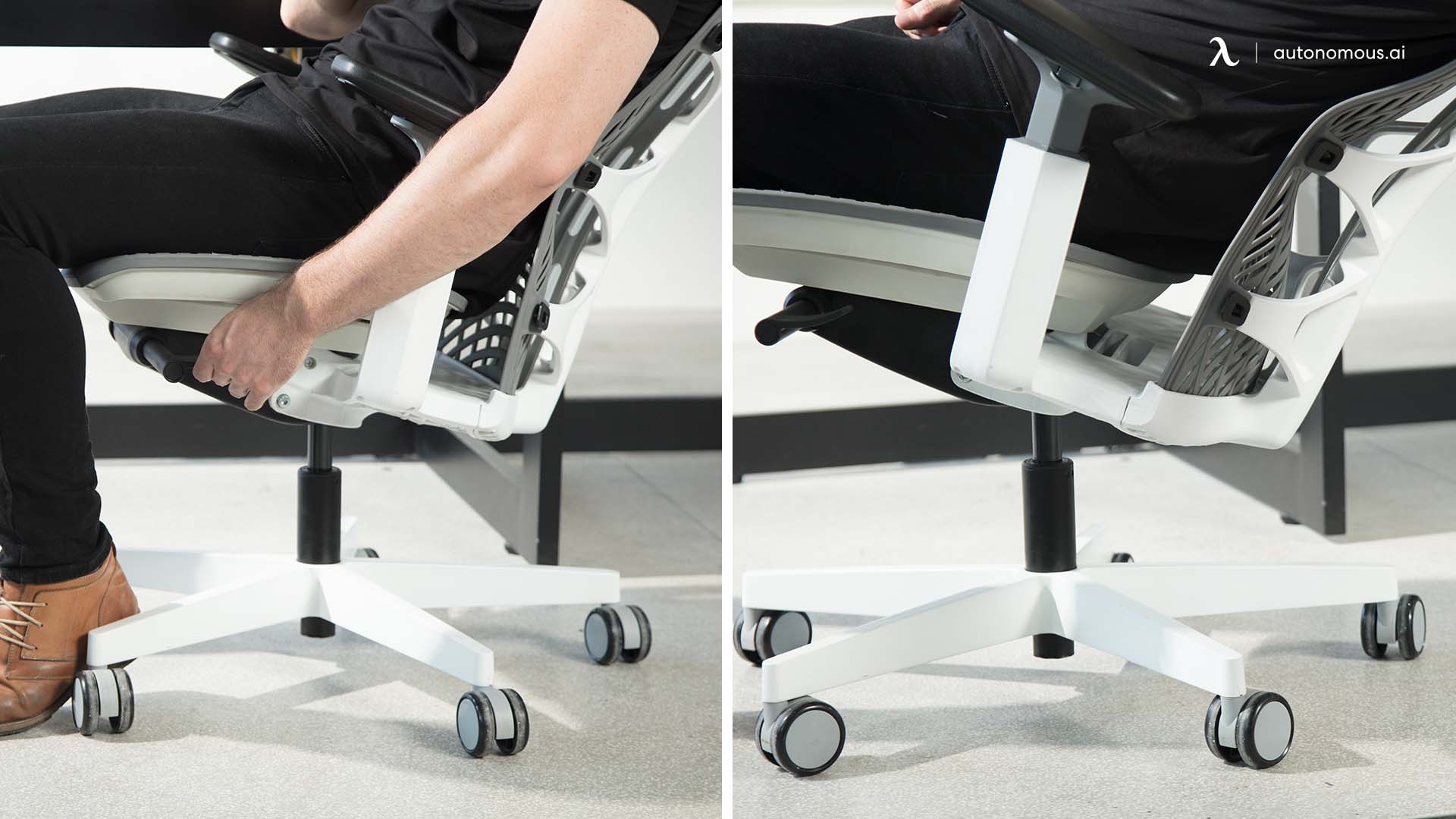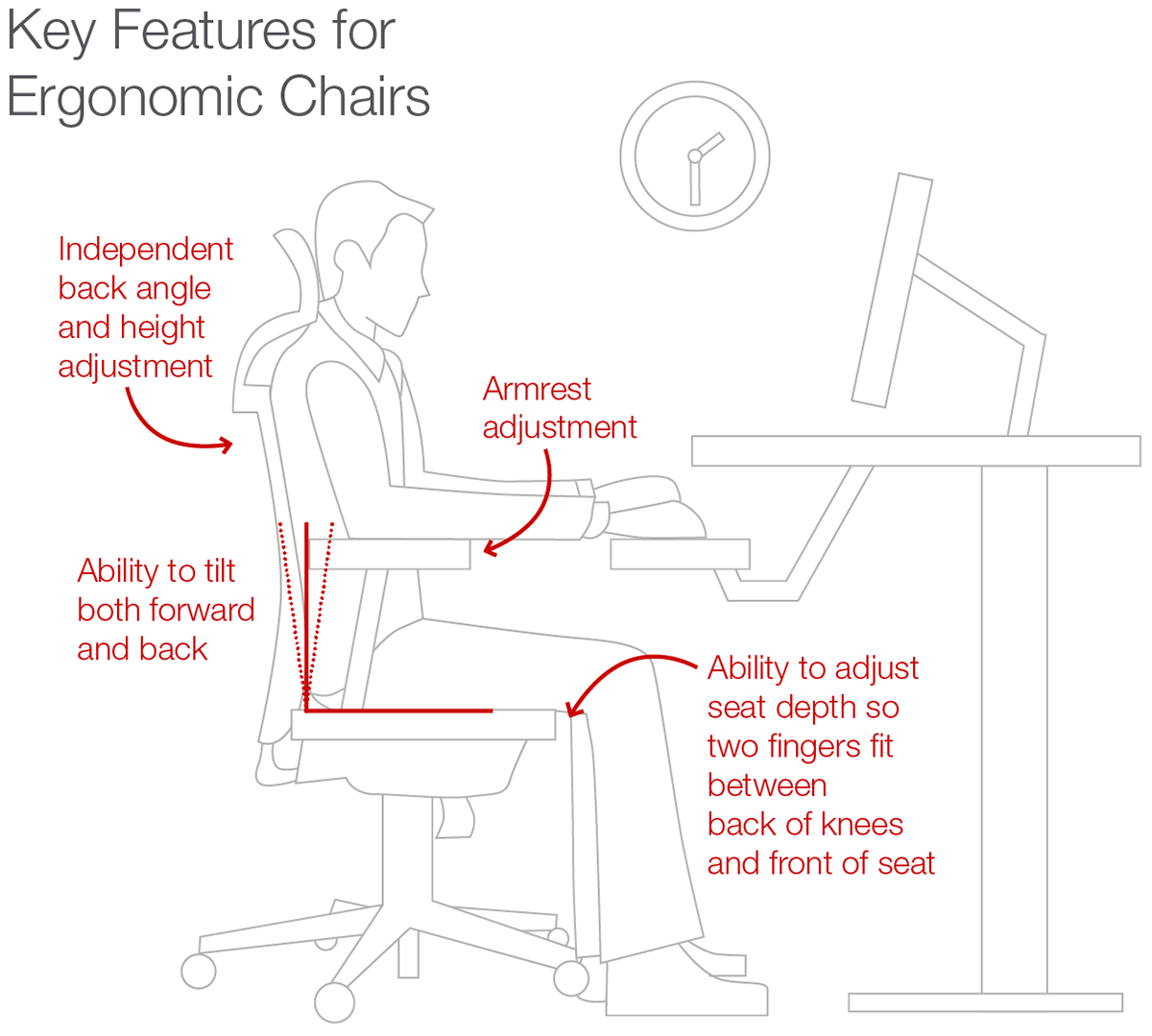Benefits of Adjusting Seat Tilt: Adjust Chair Seat Tilt
Adjusting the seat tilt on your chair is not just about finding a comfortable position; it’s about optimizing your posture, improving blood circulation, and reducing the risk of musculoskeletal problems. A properly adjusted seat tilt can significantly impact your overall well-being, especially if you spend long hours sitting.
Ergonomic Benefits
A properly adjusted seat tilt can significantly impact your posture, reducing strain on your back, neck, and shoulders. The ideal tilt angle varies depending on the individual and the task, but generally, a slight backward tilt can help maintain a natural spinal curve and reduce pressure on the lower back. This can help prevent slouching, which can lead to back pain and other musculoskeletal issues. A forward tilt, on the other hand, can be beneficial for tasks requiring more forward leaning, such as writing or using a keyboard. This can help reduce pressure on the wrists and forearms.
Improved Blood Circulation
Adjusting the seat tilt can also improve blood circulation by reducing pressure on the legs and feet. A slightly backward tilt can help elevate the legs, promoting better blood flow. This can help prevent swelling and discomfort in the legs, especially for individuals who spend long hours sitting. Conversely, a forward tilt can restrict blood flow, potentially leading to fatigue and discomfort.
Benefits for Specific Tasks
Different seat tilt positions can be beneficial for specific tasks or activities. For example, a slightly backward tilt can be beneficial for tasks requiring a relaxed posture, such as reading or watching TV. A forward tilt, on the other hand, can be beneficial for tasks requiring more focus and precision, such as writing or using a computer.
Adjusting Seat Tilt for Optimal Comfort

The tilt of your chair seat can significantly impact your posture, comfort, and overall well-being. Proper seat tilt allows for better blood circulation, reduces pressure on your spine, and optimizes your body’s natural alignment. By adjusting your chair’s seat tilt, you can create a more ergonomic workspace that supports your body and promotes comfort throughout the day.
Identifying the Correct Tilt Angle, Adjust chair seat tilt
The optimal seat tilt angle varies depending on your body type, the task at hand, and your individual preferences. A slightly reclined position can be beneficial for tasks requiring extended periods of sitting, while a more upright angle may be preferred for tasks involving reaching or movement.
- Body Type: Taller individuals may require a greater seat tilt angle to ensure their legs are comfortably positioned and their knees are slightly below their hips. Shorter individuals may find a less reclined angle more comfortable.
- Task: Tasks that involve frequent reaching or standing up may require a less reclined seat tilt, allowing for easier movement. For tasks requiring prolonged sitting, a more reclined angle can provide better support and reduce pressure on the spine.
- Individual Preferences: Ultimately, the ideal seat tilt angle is the one that feels most comfortable and supportive for your body. Experiment with different angles and find the position that best suits your needs.
Factors to Consider When Adjusting Seat Tilt
Several factors should be considered when adjusting your chair’s seat tilt to achieve optimal comfort and support.
- Back Support: The angle of your chair’s backrest should complement the seat tilt. A more reclined seat tilt may require a more upright backrest, while a less reclined seat tilt can be paired with a more reclined backrest.
- Leg Length: Your legs should be comfortably positioned with your feet flat on the floor. If your legs are too short, you may need to use a footrest or adjust the seat height. If your legs are too long, you may need to increase the seat tilt angle.
- Armrest Position: Your armrests should be at a height that allows your shoulders to relax and your elbows to be bent at a 90-degree angle. Adjusting the armrest height can also influence the optimal seat tilt angle.
Common Problems with Seat Tilt Adjustment

The seemingly simple act of adjusting your chair’s seat tilt can be fraught with frustration. From stubborn mechanisms to outright failure, a multitude of issues can arise, leaving you feeling stuck in an uncomfortable position. Understanding these common problems and how to address them can save you a lot of backache and frustration.
Identifying Common Seat Tilt Adjustment Problems
The most common problems with seat tilt adjustment mechanisms stem from wear and tear, improper use, or design flaws.
- Stiff or Jammed Mechanism: The most common issue is a stiff or jammed mechanism. This can be caused by dirt, debris, or simply the natural wear and tear of the mechanism over time. The tilt mechanism might feel difficult to move, or it might get stuck in a particular position.
- Loose or Worn Parts: Over time, the parts that make up the tilt mechanism can become loose or worn. This can lead to the seat tilting unexpectedly or not locking in place properly. The seat may also rock back and forth, causing instability and discomfort.
- Broken or Damaged Mechanism: In some cases, the tilt mechanism may be broken or damaged. This could be due to a manufacturing defect, improper use, or excessive force applied to the mechanism.
Choosing a Chair with Adjustable Seat Tilt

In the realm of ergonomic seating, adjustable seat tilt is a crucial feature that can significantly enhance comfort, posture, and overall well-being. A chair with adjustable seat tilt allows you to customize the angle of the seat to suit your individual needs and preferences. This can be particularly beneficial for tasks that require different postures, such as writing, reading, or using a computer.
Factors to Consider When Choosing a Chair with Adjustable Seat Tilt
Choosing a chair with adjustable seat tilt requires careful consideration of various factors to ensure you invest in a product that meets your specific needs and preferences.
- Range of Adjustment: The range of adjustment is a crucial factor to consider. A wider range of adjustment allows for greater customization, enabling you to find the perfect angle for various tasks and body types. Look for a chair that offers a tilt range of at least 10-15 degrees.
- Mechanism: The mechanism used for adjusting the seat tilt is equally important. A smooth and reliable mechanism ensures easy and precise adjustments. Some common mechanisms include lever-operated, knob-operated, or gas-lift systems. Consider the ease of use and durability of the mechanism.
- Lock Mechanism: A lock mechanism is essential for securing the seat tilt in your desired position. This prevents accidental adjustments and ensures stability during use. Choose a chair with a sturdy and reliable lock mechanism.
- Seat Padding and Upholstery: Comfort is paramount when choosing a chair with adjustable seat tilt. The seat padding should be comfortable and supportive, providing adequate cushioning and pressure distribution. Consider the type of upholstery, such as fabric, leather, or mesh, based on your preferences and the environment in which the chair will be used.
- Backrest Adjustment: While not directly related to seat tilt, backrest adjustment is a valuable feature to consider. A chair with adjustable backrest allows you to customize the angle and height of the backrest, promoting proper posture and spinal support.
Quality Construction and Materials
The quality of construction and materials used in a chair with adjustable seat tilt is paramount for long-term durability and reliability. Investing in a chair made with high-quality materials and robust construction will ensure it withstands the test of time and provides years of comfortable use.
- Frame Material: The frame is the backbone of the chair and should be made of durable materials such as steel, aluminum, or wood. Look for chairs with a sturdy and robust frame that can support your weight and withstand regular use.
- Seat Base: The seat base should be strong and stable, providing a solid foundation for the seat and backrest. Look for chairs with a five-star base made of high-quality materials.
- Casters: Casters are essential for easy movement and maneuverability. Choose chairs with high-quality casters that are smooth, durable, and can handle the weight of the chair without causing damage to the floor.
Recommendations for Chairs with Adjustable Seat Tilt
When choosing a chair with adjustable seat tilt, consider your specific needs and preferences. Here are some recommendations for chairs that cater to different requirements:
- For Home Office Use: Look for chairs with a comfortable seat, adjustable backrest, and a wide range of seat tilt adjustment. Consider chairs with lumbar support and armrests for enhanced comfort.
- For Gaming: Choose chairs with a sturdy frame, adjustable seat tilt, and high-quality casters. Look for chairs with a racing-style design and ergonomic features that promote comfort and support during long gaming sessions.
- For Professionals: Consider chairs with adjustable seat tilt, lumbar support, and adjustable armrests. Look for chairs with a professional aesthetic and durable construction that can withstand the demands of a busy work environment.
Adjust chair seat tilt – Adjusting your chair seat tilt can be a game-changer for your posture and comfort, especially if you spend long hours sitting. While I usually think of practical adjustments, I can’t help but imagine the ultimate throne for such a task – a royal blue throne chair ! Imagine, a chair that embodies power and prestige, with the added benefit of a perfect tilt to ensure regal comfort.
Of course, finding that perfect tilt for your everyday chair is just as important, even if it doesn’t come with a royal blue finish.
Adjusting your chair seat tilt is a simple yet powerful way to improve your posture and comfort. A slight recline can take pressure off your lower back, while a more upright position can help you focus and stay alert.
If you’re looking for a stylish and functional chair to enhance your workspace, consider a baby blue office chair – they’re surprisingly versatile and can add a touch of personality to any office. No matter what chair you choose, don’t forget to experiment with the seat tilt to find the perfect position for your body.
